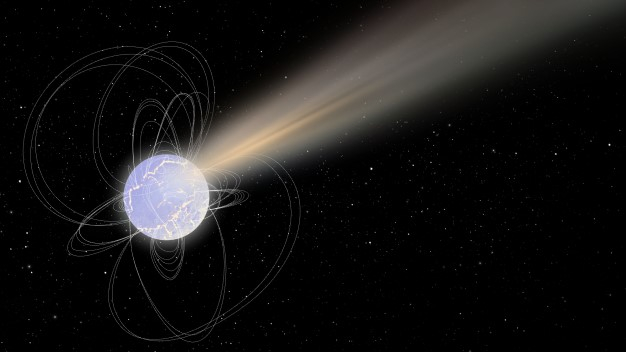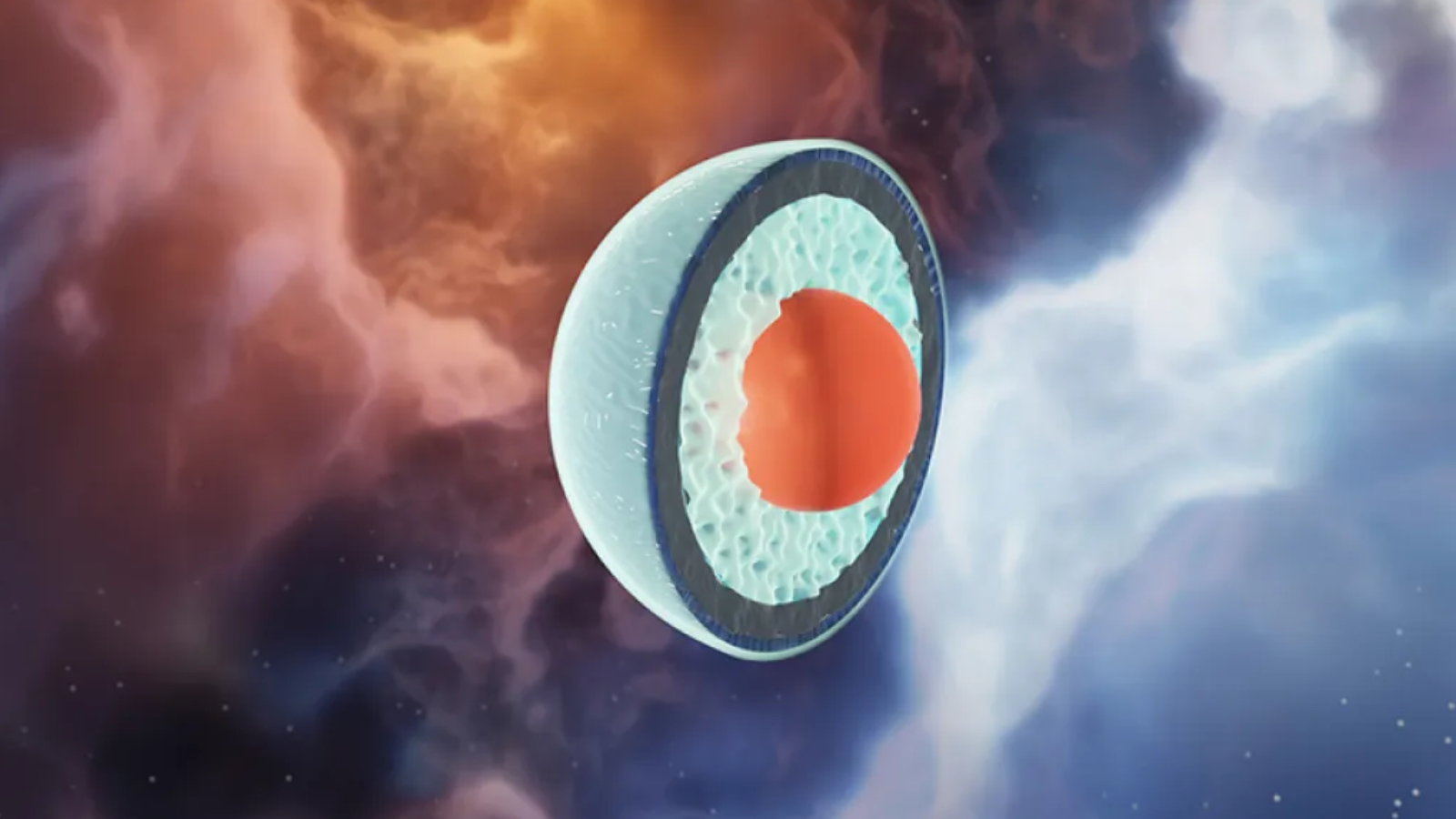Dead star 'glitches' could reveal the origins of fast radio bursts
The highly magnetic neutron star underwent two massive shifts in velocity and then slowed down due to powerful magnetar winds.

Astronomers have observed powerful "glitches" in a highly magnetic neutron star, or magnetar, near the heart of the Milky Way. These glitches appear to have massively accelerated the star's spin speed.
Plus, fascinatingly, the phenomenon that helps slow down the neutron star (also known as a dead star) after these glitches could help reveal the star's interior. Understanding what goes on within a magnetar may finally unveil how these strange bodies launch what are known as "Fast Radio Bursts," or FRBs.
FRBs are mysterious and fleeting pulses of light that can get bright enough to briefly outshine the light of an entire galaxy. Scientists know these extreme, few-second-long pulses exist, but no one has been able to pinpoint precisely why they exist.
The discovery team studied a magnetar that's considered the most active in our galaxy over the last decade, SGR 1935+2154 (SGR 1935). It's located an estimated 30,000 light-years away from Earth, and was studied using the Neutron Star Interior Composition Explorer (NICER) instrument aboard the International Space Station ans well as the Nuclear Spectroscopic Telescope Array (NuSTAR) space telescope. With these tools in hand, the team spotted two massive glitches associated with the magnetar that were separated by around nine hours.
"The glitches are abrupt changes in the rotation of the star. Each brief observation allows us to measure the rotation speed of the magnetar and we noticed that suddenly the star was spinning faster than the previous observation," team member and assistant professor at Paul Sabatier University in France, Sebastien Guillot, told Space.com. "Glitches are commonly observed for pulsars and magnetars, but these are two of the largest ever seen."
This magnetar usually spins just over 3 times per second, but the first glitch caused an increase in rotation speed. Then, the second glitch that occurred approximately nine hours later caused yet another speed increase 100 times greater than the first.
Get the Space.com Newsletter
Breaking space news, the latest updates on rocket launches, skywatching events and more!
"During the interval between these two glitches, we observed a significant decrease in the neutron star's rotation speed, decelerating at a rate 100 times faster than its speed before the glitch, and approximately 1000 times faster than its long-term average," Chin-Ping Hu, research lead and an associate professor at the National Changhua University of Education, told Space.com. "This slowdown occurred over a period longer than the duration of the glitches themselves."
Exactly between the two glitches, SGR 1935 launched an FRB, and after both acceleration-jumps, the neutron star somehow slowed back down to its normal rotation rate, leaving the team eager to explain both phenomena.

Magnetars, like all neutron stars, owe their births to the deaths of once massive stars. After millions of years of burning hydrogen in their cores and converting it to helium, stars that are many times the size of the sun run out of this nuclear fusion fuel supply. The end of that supply also ends the outward energy flow coming from the core of the star, the force that had been supporting it against the inward force of its own gravity for so very long.
As this cosmic tug of war ends (with gravity the clear winner) the outer layers of the star are blown apart in a powerful supernova explosion while the inner core collapses upon itself. This creates a stellar remnant that has between one and two times the mass of the sun squeezed into a sphere with a diameter of around 12 miles (19 kilometers.)
This is a neutron star.
Not only does this entire situation create neutron star matter so dense a teaspoon of it would weigh something like 1 billion tons, but, like an ice skater drawing in their arms to spin faster, the rapidly shrinking radius increases the stellar remnant's spin rate. In fact, some neutron stars can rotate as fast as 700 times per second.
The collapse also pushes together the magnetic field lines of the dying star, creating some of the universe's most powerful magnetic fields. There are neutron stars out there that boast a powerful magnetic field so intense they qualify for their own category of celestial object. Those are the magnetars.
The team behind this research theorizes that the return to normal speed for the magnetar SGR 1935 is the result of a strong, ephemeral and magnetospheric wind blowing from the star. Chin-Ping Hu says this wind would carry away angular momentum that rapidly slows the star's rotational rate.
"The idea is that the crust of the magnetar would crack under the torque forces at play," Guillot said. "This cracking just under the surface of the magnetar releases a huge amount of energy that would locally heat up the surface, sending particles in the form of a plasma of ions and electrons at high temperatures into space at close to the speed of light."
The team also thinks the same phenomenon that couples the neutron star's interior with its surface to cause this wind is responsible for the magnetar's X-ray emission being boosted. Potentially, it'd foster the right magnetic conditions for launch FRBs as well.
"In addition to transfer angular momentum from the superfluid component, the glitches also release energy and likely twist the magnetic fields. These could trigger short X-ray bursts and flares," Chin-Ping Hu added. "These X-ray events could then change the environment in the magnetosphere, making it more suitable for FRB emission, which is a laser-like process that requires a clean environment.
"We have detected spectral changes between the glitches, hinting at a change in the magnetosphere."
Neutron star secrets
Guillot added that the magnitude of glitches experienced by SGR 1935 could help scientists better understand the interiors of this magnetar and of neutron stars in general.
"For pulsars and magnetars, the changes in the rotation during glitches are thought to be linked to the presence of superfluid material, neutrons that are not interacting with the rest of the crust and outer core of the magnetar, inside the object," he said. "During the progressive slow down of the magnetar, the superfluid material remains at the same rotation speed, until the difference of rotation speed between the bulk of the magnetar and the superfluid material is too large."
At this point, Guillot explained that the two components of the magnetar combine once more, generating the glitch in rotation — or, in other words, the abrupt spin-up of the magnetar.
"Here, the very large amplitude of two glitches within nine hours for SGR 1935 tells us that the fraction of superfluid material is quite large, several tens of per cent of the entire magnetar," Guillot continued. "This tells us a lot about the interior of magnetars."
The researcher explained that the next step in the process is to attempt to catch either this magnetar or another one in the Milky Way in the act of burping out an FRB.
"We missed the exact moment of the FRB. Not by much… But unfortunately, because of the orbit of the satellites around the Earth, our planet was occulting [passing in front of] the magnetar at the time," Guillot concluded. "SGR 1935 proves to be quite an active magnetar, and similar bursting activity will likely happen again, and hopefully, next time, we will catch it."
The team's research was published on Wednesday (Feb. 12) in the journal Nature.
Join our Space Forums to keep talking space on the latest missions, night sky and more! And if you have a news tip, correction or comment, let us know at: community@space.com.

Robert Lea is a science journalist in the U.K. whose articles have been published in Physics World, New Scientist, Astronomy Magazine, All About Space, Newsweek and ZME Science. He also writes about science communication for Elsevier and the European Journal of Physics. Rob holds a bachelor of science degree in physics and astronomy from the U.K.’s Open University. Follow him on Twitter @sciencef1rst.
-
Torbjorn Larsson Looks like a tremendous observation from coincidental factors involving distances and alignments:Reply
Until 2020, almost all known FRBs originated in faraway galaxies. ... The team watched the neutron star rotate by virtue of a hotspot on its surface, which likely marks one of the poles of the star’s magnetic field. As the hotspot spins in and out of view — 3.2 times every second! —the neutron star’s brightness appears to pulse.
https://skyandtelescope.org/astronomy-news/neutron-star-glitches-key-mysterious-radio-bursts/
It potentially explains neutron star superfluid innards and superfluid/hard crust coupling as well as FRBs in magnetars and some rapidly spinning neutron stars.
"These X-ray events could then change the environment in the magnetosphere, making it more suitable for FRB emission, which is a laser-like process that requires a clean environment.
The paper mentions a pair-production cascade model that implies the laser analog process .
That makes sense, though, if the glitch marked a starquake also released charged particles in a brief blast of wind. That wind would have robbed the star of its spin almost as quickly as it had gained it.
Then, with all of those particles hanging around in an uber-powerful magnetic field — which is far stronger than any we can make on Earth — the conditions were right for an extreme scenario. Particles (specifically, electrons and their antimatter partners, positrons) are born in pairs from the magnetic field's energy, resulting in what Hu calls an “avalanche.”
“One electron makes a pair, and then each child makes several more, and so on for several generations, until there are thousands of progenies per electron,” he says. These electron-positron pairs could ultimately be responsible for the sudden burst of radio emission in a “laser-like process,” Hu adds.









